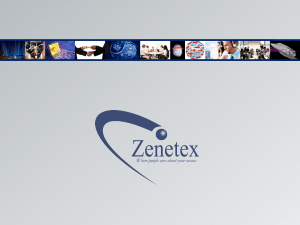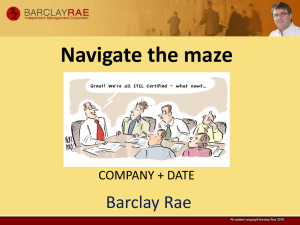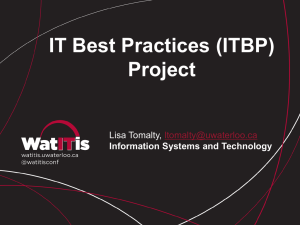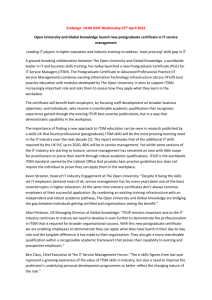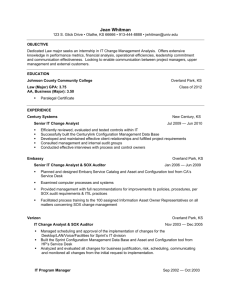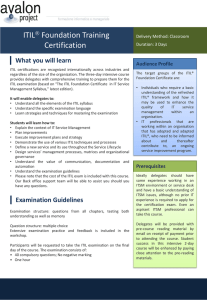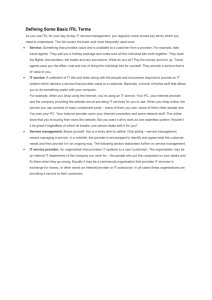BCIS 5520 IT Service Management ITSM Service Strategy, Functions & Processes
advertisement
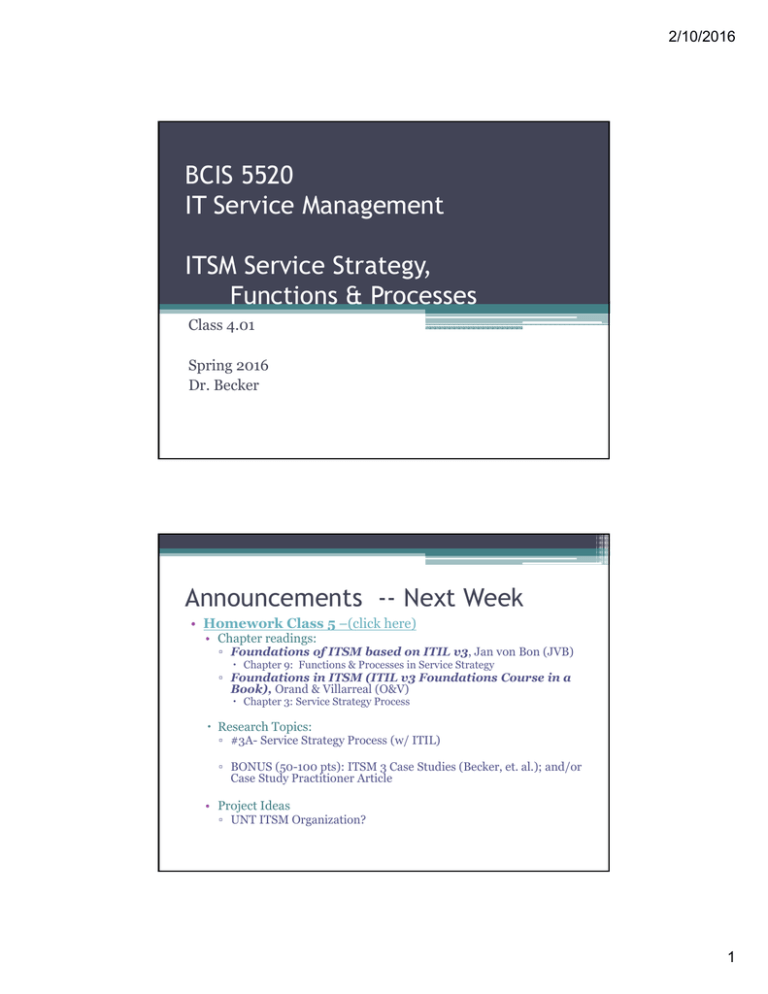
2/10/2016 BCIS 5520 IT Service Management ITSM Service Strategy, Functions & Processes Class 4.01 Spring 2016 Dr. Becker Announcements -- Next Week • Homework Class 5 –(click here) • Chapter readings: ▫ Foundations of ITSM based on ITIL v3, Jan von Bon (JVB) Chapter 9: Functions & Processes in Service Strategy ▫ Foundations in ITSM (ITIL v3 Foundations Course in a Book), Orand & Villarreal (O&V) Chapter 3: Service Strategy Process Research Topics: ▫ #3A- Service Strategy Process (w/ ITIL) ▫ BONUS (50-100 pts): ITSM 3 Case Studies (Becker, et. al.); and/or Case Study Practitioner Article • Project Ideas ▫ UNT ITSM Organization? 1 2/10/2016 Readings Tonight • Homework Class 4 – • Chapter readings: ▫ Foundations of ITSM based on ITIL v3, von Bon Chapter 8: Introduction to Functions & Processes ▫ Foundations in ITSM (ITIL v3 Foundations Course in a Book), Orand & Villarreal (O&V) Chapter 2: Service Strategy (follow-up to last week’s readings) ▫ Research Topics: ▫ #2A- ITSM Service Strategy; ITSM CSFs and KPIs ▫ Frameworks, Models, & Theories: Link Extra Handout ▫ 2012 SIMPosium Conference Presentation: “How IT Governance Facilitates Alignment & Resource Optimization” Ernst and Young (Suzuki, Turcotte, Hamaker) Past Project Ideas UNT ITSM Organization 1. Policy, Process, and Documentation Templates –for Key UNT IT forms (ITSM ITIL Library) 2. Tool Set (e.g., Remedy) Specification & Evaluation—e.g., Change Management, etc. 3. Balance Scorecard and Metrics Project Guidance on the use and implementation of BSC and its value to decision makers 2 2/10/2016 Past Project Ideas (continued) UNT ITSM Organization 4. Change Management Plan for one UNT Organization Component 5. Organizational and Cultural Change Issues associated with ITIL implementations. How to manage or avoid the pitfalls? 6. Service Catalog, SLA, and Service Level Objectives (Requirements); Service Design Phase Guidance on the creation and relationship of these 3 items and templates. Past Project Ideas (continued) UNT ITSM Organization 7. ITIL Implementation Plan TEMPLATE Provides guidance for creating an Implementation (Transition or Operation or Whole Cycle) Plan Becker Favorites: 8. Can ITIL Actually Improve Project Success Rates or ROI? 9. KEDARit ITSM tool Project (SUM™) 3 2/10/2016 2014-2015 Project Topics 1. Johnson, Chris, “ITIL and Surveillance Camera Services at UNT” 2. Kisner, Matthew, “A Framework for Identifying and Selecting an ITSM Tool.” 3. Perez, Christian, “IT Service Management: Release Management and Agile Development” 4. Ashraf, Mehnaz, “Soft Issues and Organizational Cultural: Imperative to Successful ITSM process implementation” Ballard, Jessica, “Service Desk ITIL Compliance through SaaS” Crook, Brandon, “Utilizing ITIL for Information Security Management (ISM)” Franco, Juan, “Return On Investment Of An ITIL V3 Implementation” Hart, Andrew, “Availability Management Approach (With Six Sigma Tools) to Meet or Exceed Established Service Level Agreements (SLAs)?” Morris, Kevin, “Master Data Management (MDM) and ITIL” 5. 6. 7. 8. 9. ITIL ITSM Lifecycle: 5 Stages 1. 2. 3. 4. 5. Service Strategy Service Design Service Transition Service Operation Continual Service Improvement 4 2/10/2016 1.4 Why is ITIL So Successful? (Copied from the ITIL Best Practices Library) ITIL embraces a practical approach to service management – do what works. And what works is adapting a common framework of practices that unite all areas of IT service provision towards a single aim – that of delivering value to the business. The following list defines the key characteristics of ITIL that contribute to its global success: Vendor-neutral ITIL service management practices are applicable in any IT organization because they are not based on any particular technology platform or industry type. ITIL is owned by the UK government and is not tied to any commercial proprietary practice or solution. Non-prescriptive ITIL offers robust, mature and time-tested practices that have applicability to all types of service organization. It continues to be useful and relevant in public and private sectors, internal and external service providers, small, medium and large enterprises, and within any technical environment. Organizations should adopt ITIL and adapt it to meet the needs of the IT organization and their customers. Best practice ITIL represents the learning experiences and thought leadership of the world’s best-in-class service providers. ITIL is successful because it describes practices that enable organizations to deliver benefits, return on investment and sustained success. ITIL is adopted by organizations to enable them to: 1. Deliver value for customers through services 2. Integrate the strategy for services with the business strategy and customer needs 3. Measure, monitor and optimize IT services and service provider performance 4. Manage the IT investment and budget 5. Manage risk 6. Manage knowledge 7. Manage capabilities and resources to deliver services effectively and efficiently 8. Enable adoption of a standard approach to service management across the enterprise 9. Change the organizational culture to support the achievement of sustained success 10. Improve the interaction and relationship with customers 11. Coordinate the delivery of goods and services across the value network 12. Optimize and reduce costs. Main Output of Service Strategy • Service Level Package (SLP) includes: ▫ Strategic Business Requirements ▫ Feasibility & Guiding constraints IT exists to create services and value NOT to provide technology TESO – Technology, Economic/Financial, Staff, Organization ▫ Process Requirements ▫ Serves as the input to the Service Design stage 5 2/10/2016 Value Through Service • Value created by Soft • Value created by Assets: Hard Assets: ▫ Soft Assets ▫ Hard Assets Management Organization Process Knowledge People Financial Capital Infrastructure Applications Information People Service Value Chain • Service Assets provide potential for • Services, which provide performance potential for • Customer Assets, which provide value potential for • Business Outcomes! (ROI) 6 2/10/2016 Types of Services (Core & Support) • Core Service ▫ ATM dispense cash • Enabling Service ▫ Power, telecommunication, etc. • Enhancing Service ▫ Printing an ATM receipt • Combinations of all types of services are call Service Packages or Service Level Packages (SLP) 14 Value Chain Analysis Value Chain Analysis (Porter) is a process of analyzing an organization’s activities to determine where value is added to products and/or services and what costs are incurred in doing so. 7 2/10/2016 Defining the SLP with Shared Activities (Service Strategy) 1. Define the Market ▫ Understand the Customer 2. Develop the Offerings ▫ Define the Service deliverables 3. Develop the Strategic Assets ▫ Develop/Identify Required Resources and Capabilities 4. Prepare for Execution ▫ ▫ Project planning Define the CFSs & Measurable outcomes Types of ITIL Questions Raised (recall)? • • • • • • What is our market? What does the market want? Do we have something unique to offer? Do we have the right portfolio? Do we have the right service catalogue? Are services designed properly? 8 2/10/2016 Critical Success Factors • A.k.a, Strategic Industrial Factors (SIF) ▫ ▫ ▫ ▫ ▫ ▫ ▫ Defined in terms of capabilities and resources Are key to success for market leaders Defined at the market level Basis for competition among rivals Dynamic (time dimension) Capital intensive to develop Measurable value calculated through a combination of other factors Introduction to Functions & Processes • • • • • • • • Introduction Management of Processes Teams, Roles & Positions in ITSM Tools used in ITSM Communication in IT Service Organizations Culture Processes, projects, programs & portfolios Functions & processes in the Lifecycle phases 9 2/10/2016 Processes & Functions • Process: A structured set of activities designed to accomplish a specific set of objectives (IPO) ▫ Measureable; specific output; Customer; Respond to trigger • Function: Units of organization specialized to perform certain types of work and responsible for specific outcomes ▫ E.g.: Service desk, help desk, IT operations teams, etc. Management of Processes • Process: ▫ A structured set of activities designed to accomplish a defined objective ▫ Classic IPO System Model Input Process Output ▫ Leads to Procedures (who & how) and work instructions (detailed steps in a procedure) 10 2/10/2016 Organizational Strategy Determines Information Systems Processes & Functions Nature of Functions & Processes • First Master Internal Processes ▫ Value chain inside the organization (SCM) • Then Master the External Processes ▫ Customer-oriented processes (CRM) • Goal is to: ▫ Evolve to a Mature customer-focused organization 11 2/10/2016 Processes and Departments ITIL Best practices can help determine the most effective and Efficient series of activities Teams, Roles and Positions in ITSM • Tasks may be performed by: ▫ Groups; Teams; Departments; Divisions, etc. • Organizations may be arranged as ▫ ▫ ▫ ▫ ▫ Hierarchical Organizations Flat Organizations Network Organizations Project Organizations Process Organizations 12 2/10/2016 ITSM Tool Sets • Automated Support (Top 10) 1. BMC Software Remedy ITSM 2. IBM Tivoli Service Request 3. FrontRange ITSM 4. TechExcel ServiceWise 5. Vivantio Service Desk 6. CA IT Service Mgt 7. Numara Footprints 8. EMC Infra ITIL SM 9. Epicor ITSM 10. SunView ChangeGear Products Communication Within IT Service Organizations • People, process, partners, & technology (hardware & software) ▫ Recall the 5-Component Model (data; SDLC) ▫ #1 People • Can there be TOO much documentation, regulation and control? ▫ Create a Clear & Concise Communication Policy • Identify the Formal communication structures: ▫ Reporting; Meetings; Online facilities; Notice boards 13 2/10/2016 Organization Culture • The way that people deal with each other in the organization… such as: ▫ ▫ ▫ ▫ ▫ ▫ Autocratic Democratic Teaming Innovative Dog-eat-dog Nuturing Process, projects, programs, and Portfolios • Define for each organization: ▫ Processes A structured set of activities to accomplish a defined objective ▫ Projects A temporary organization to achieve an objective ▫ Programs A set projects that are inter-related ▫ Portfolios A collection of projects & programs brought together for the sake of control, coordination and optimizations 14 2/10/2016 Example Application Portfolio Functions and Processes in the Lifecycle Phases • Chapters 9-13 in JVB were designed as follows: ▫ ▫ ▫ ▫ ▫ Introduction Activities, Methods and Techniques Interfaces Metrics Implementation 15 2/10/2016 ITIL ITSM Lifecycle 1. 2. 3. 4. 5. Service Strategy Service Design Service Transition Service Operation Continual Service Improvement ITSM Service Strategy & Functions & Processes: Summary • ITIL provides a structured framework based upon best practices and management theory • Functions and Processes are the “muscles and bones” for the organizational service delivery systems • ITIL V3 incorporates the Lifecycle approach to ITSM in order to best manage Functions and Processes from their definition through their implementation 16 2/10/2016 What is IT Governance? ISACA was formerly known as Information Systems Audit and Control Association 2012 SIMPosium Conference Presentation: “How IT Governance Facilitates Alignment & Resource Optimization” Ernst and Young (Suzuki, Turcotte, & Hamaker) Key Points: 1. Volatility, Velocity, and Visibility (VVV) 2. Difference between Governance & Management Processes 3. ISACA’s COBIT Framework for Governance 4. Current State, Future State, How to Get There? 5. KPI’s and ROI 17 2/10/2016 IT Service Management & IT Governance With ITIL and COBIT Frameworks • ICIS Paper (2006) Handout Class #1 • Panel Discussion; SIM Academic Workshop / ICIS 2006 Milwaukee, WI “Dynamic Reconfiguration Deployment?” Dr. Jack D. Becker University of North Texas Catherine Szpindor Retired - VP of IT, Sprint-Nextel Executive on Grounds – UVA Peter Beasley Principal, NetWatch Solutions, Inc. “How IT Governance Facilitates Alignment & Resource Optimization” --Ernst and Young (Suzuki, Turcotte, & Hamaker) • Class (paper link) Discussion • Dynamic Reconfiguration Deployment? ▫ Standards, Best Practices (ITIL), Governance, Alignment, Agility, CMDB (ITIL), Competitive Advantage 18 2/10/2016 IT Challenges: • Shorter cycle times • Rapid deployment • Mass Customization • Same Day Services • Anytime, Anywhere, Anyplace • WWWW (mobility) 19 2/10/2016 POCIS (5 basic): Planning, Organizing, Controlling, Influencing (/Directing), and Staffing What about Leading? a.k.a., Deliver a.k.a., Functions ISACA’S COBIT framework (v5.0) 20 2/10/2016 ISACA’s COBIT Framework (v5.0) Governance Processes (at top of fig.) • Evaluate, Direct, Monitor ▫ EDM01: Ensure governance framework setting and maintenance ▫ EDM02: Ensure benefits delivery ▫ EDM03: Ensure risk optimization ▫ EDM04: Ensure resource optimization ▫ EDM05: Ensure stakeholder transparency 21 2/10/2016 22 2/10/2016 Concluding Note (More on these to come) : ITIL Defines 3 Strategic Process Levels • Financial Management ▫ Service Value Provisioning value (production costs), ROI Service value potential (value-adding component) • Demand Management (DM) ▫ Managing Customer Expectations ▫ SLAs based upon: Patterns of Business Activity (PBA) Service Level Packages (SLP) • Service Portfolio Management (SPM) ▫ Document and manage SP; Optimize Value & Control Costs & Risks 23 2/10/2016 Summary • Compare and contrast the Lifecycle Approach to the Functions & Process Approach to IT Service Management • Provide examples of Models and Frameworks provided in this lecture • IT Governance, ITIL, and ROI ▫ Competitive Advantage, Dynamic Reconfiguration of Resources 24

